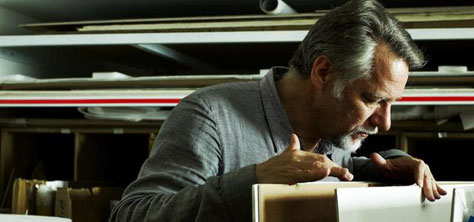
Refined Crude
In his ROM photo exhibit about the impact of oil, Edward Burtynsky once again creates haunting images of modern landscapes.
—
Edward Burtynsky’s beautiful and disturbing photographs force the viewer to think about humanity’s ability to transform nature. His just-opened show at the Royal Ontario Museum, “Edward Burtynsky: Oil,” consists of 53 provocative, large-format photos that explore the effects of the world’s dependence on this limited resource. It’s the latest achievement for one of Canada’s most celebrated artists, whose work is included in the collections of such renowned venues as the Museum of Modern Art, the Guggenheim Museum and the Bibliothèque nationale de France in Paris.
This is a busy time for Burtynsky: on April 14, he’ll receive the $20,000 MOCCA Award in Canadian Art, in honour of his astounding, three-decade career. He spoke to Eye Weekly about the path toward his latest exhibition.
Tell me about the genesis of the exhibition—when did you start thinking about oil?
Somewhere around the mid-’90s I began to consider oil, and in 1997 I began to actively work on it. I refer to it as my oil epiphany. I was driving up north to do a project on mining, and it occurred to me that mining was not new to humankind, but what had changed about mining in the 20th century was the speed and scale of it. It was oil and the internal combustion engine that allowed us the mobility and ability to farm, to mine and to build cities [on this new] scale.
I realized that I had never had an idea of where oil came from, or what the machinery that makes it looks like. I began to think about the way everything has literally been touched by oil at some level—our clothes, our transport, our buildings, our food. I wanted to reconnect with the places that provide us with the all-important fuel that allows us to live the way we live. That was the beginning.
When you’re making your pictures, are you making them with a message in mind?
Every picture that I’ve made in the last 30 years is, at its core, about the altered landscape, about man transforming landscape. Everything I photograph is about the loss of that natural space. It’s a lament for its loss. I’m a quiet advocate for that place that’s being harmed for our short-term gains because we largely see nature as a cupboard where we go to get stuff. We don’t see nature as that primal thing that belongs here, that its right to be here is profound. There’s a lot of hubris in human-kind. We think too highly of ourselves. We’re not careful enough with the fact that we’re custodians of the planet.
How do you decide what to shoot?
There are a couple of simple questions that I always ask: How does a place become significant and why? And what places have scale to them? If you’ve seen the movie There Will Be Blood, you know that’s where the oil was discovered—in southern California. So I said, “I’ve gotta go there.
What was your trajectory from there?
I did some other refineries on the east coast. And I did a refinery outside of Toronto that is no longer there. Report on Business magazine wanted me to shoot pictures for a story on the Alberta oil sands. I was interested in going there because I was already researching the oil sands—they are the largest known reserve of oil on the planet after Saudi Arabia.
Were there places that you wanted to shoot that you couldn’t?
Oh, tons. I tried for three years to shoot in Saudi Arabia. I was talking to Saudi Aramco, a huge company that is a joint venture between the USA and Saudi Arabia. It is the biggest oil company in the world…. In the end they just said no.
Now that you’ve wrapped up “Oil,” has your thinking about this subject changed from when you started taking pictures of it?
It’s clear that we better find another way to fuel our cars. As we burn the stuff, we’re shoving it into the atmosphere so we have climate change. We’re so dependent on oil that if anything happens to its supply, our standard of living collapses so quickly. We’re absolutely reckless with oil given that it is this precious, limited, finite, valuable resource. Conservation is the low-hanging fruit. I remember, at the TED conference in 2005, seeing a guy from General Motors go on stage and talk about all the energy-efficient things they were going to do. But that year they issued eight brand new vehicles and each was a huge gas-guzzling monster car.
One of the sections in the show is called “the end of oil.” What does this phrase mean to you?
In 2006, I went to Azerbaijan. It’s one of the few places in the world where you can see oil on the ground. Most of the time if you see oil on the ground it’s a problem. It’s like blood on the ground. Oil is always contained. But there it was right out in the open. So I got to photograph that. And then I got to thinking that the end of the oil cycle is really interesting. It creates its own landscapes—a post-consumer waste landscape.